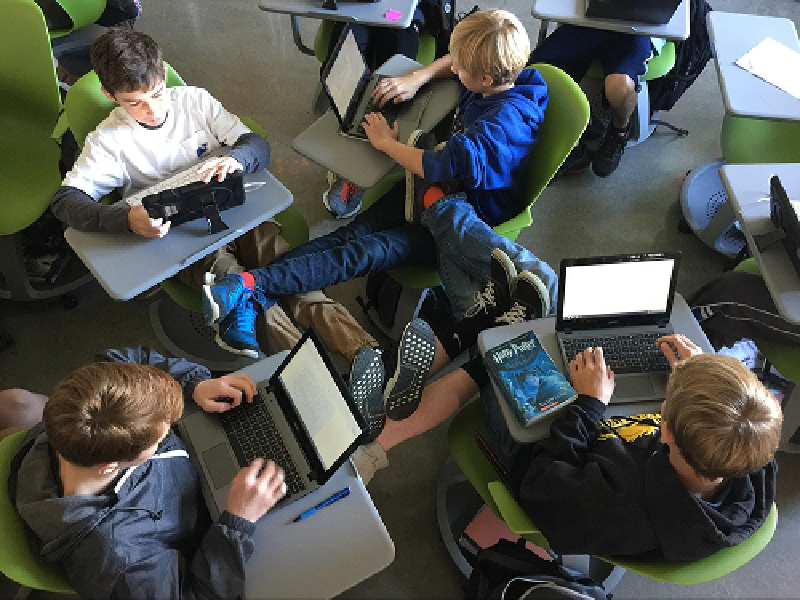One of the smartest lessons I learned my first year in the classroom was to steal everything you can from other teachers. Grab those handouts left in the copy room. Pay attention over that cafeteria lunch when they brag about what’s working with their students. Eavesdrop when your students talk enthusiastically about what they’re loving in another class. Don’t try to reinvent the wheel!
So today we bring you tips and tricks from some experienced NaNoWriMo teachers, all the way from 1st grade novelists through college Wrimos. Best news? These tips are free! No stealing necessary. Please take what looks good for you and your students.
Elementary
“Don’t underestimate what kids can do! When I taught NaNoWriMo to first graders, I was amazed by how much confidence and creativity my little students exhibited. They felt grown-up (in the best way) writing their novels and were so proud of their work. Self-identifying as writers—even NOVELISTS—was such a huge shift for them.” -Lily, 1st grade teacher
“We make a list of titles every year and read the titles from the previous year to them. It really helps those who are not sure what they want to write. Who is not motivated by ‘Capybara on an Adventure’?” -Jake, 3rd grade teacher
“I often encourage students to start a new chapter when they feel stuck. And I always tell them that the chapters don’t have to be sequential or even related. The next chapter can be in a different place or time. The important thing is to keep going.” -Jake, 3rd grade teacher
“Don’t set the same word count goal for everyone. They are in such different places. Some students will go home every night and write 500 words, some will struggle to write 300 words in a week. And don’t limit them. Sometimes we have a third grader write 30,000 words and it’s not necessarily who I thought it would be.” -Jake, 3rd grade teacher
Middle School
“My middle school students love to be in charge and make their own decisions, so allowing them to choose their writing spot in the classroom during NaNoWriMo was popular with them. If they were seated at individual desks, they were allowed to move to an area different from their assigned seat, which could provide another vantage point for inspiration. Examples included: a window view, in front of a favorite poster on the wall, next to a bookshelf, by a supportive friend to share ideas, on the floor, or even outside in the sunshine. If students were seated at tables they could mix it up, but always with the instructions to choose wisely, join students who were seated alone, invite others to their tables, or sit by themselves in unoccupied spaces. They loved the physical independence of seat location and the creative independence of writing their own novel, so moving around was never a problem.” -Carol, 8th grade English teacher

“One of the aspects of NaNoWriMo that overwhelmed me at first was thinking I was going to have to grade 100 different novels. How could I possibly read all of that writing and respond with constructive, meaningful feedback to every student? I quickly learned that this is a project where it’s OK to grade excerpts of the novel that focus on the various skills we teach in conjunction with the project. When I broke it down into smaller pieces, the assessment piece of the puzzle fell right into place.“ -Alec, 8th grade English Language Arts teacher
(Check out the Young Novelist Challenge resources, where you’ll find Alec’s rubrics in the secondary curriculum folders. You could also modify them for elementary school students.)
High School
“Create a holding cell - a physical box is perfect - where students can store their internal editors until December. Have them draw those critical characters on paper and lock them away so the creator voice has free rein!” -Wyatt, middle / high school teacher

“I really like the ‘Lists, lists and lists of lists’ activity from the Young Novelist Challenge Workbook. As it says in the Workbook, these listing exercises can help us discover something new about our characters as well as generate new plot ideas. But something I’ve learned is that it is really helpful to save this activity until the middle of November. Just when my students feel like they’ve run out of ideas, like they can’t possibly write another word, like their characters have stalled in the muddy middle, I have them all stop and make lists of:
- Hidden things in this character’s room
- Things in this character’s refrigerator and freezer
- This character’s bad habits
- What this character daydreams about
- Activities this character did before ending up in your novel
“Listing is a great way to unstick the creative brain and let silly ideas out. Sometimes those silly ideas are what we need to move on to the next chapter.” -Krista, 10th grade English teacher
College
“Write along with your students. I wrote 50,000 words every November with them. As a teacher, it’s important to experience NaNoWriMo fully. Getting in the trenches with your fellow writer/students and actually creating a world and a story makes an incredible difference in the classroom." -Tom, university lecturer emeritus
“Letting students know that they only need to envision about 10-15% of the story before they begin. That was the sweet spot for most students, and it made the process less intimidating. The novelist E.L. Doctorow said, ‘Writing a novel is like driving a car at night. You can only see as far as your headlights, but you can make the whole trip that way.’" -Tom, university lecturer emeritus
“I often encouraged students to think in terms of FIVE/FIVEs while planning their novel. 5 characters, 5 scenes, 5 settings, 5 plot lines, and perhaps 5 interesting objects. I asked students to handwrite those 5/5s on a piece of paper as a reference, a bit like a checklist. Our writerly imaginations filled in the rest of the story throughout November.” -Tom, university lecturer emeritus
Tackling NaNoWriMo in the classroom can seem daunting, but if you stand on the shoulders of NaNo teachers who came before you, it is not only possible but fun. Check out our Young Novelist Challenge resources for day-by-day curriculum and workbooks, and subscribe to our newsletter for weekly tips, tricks, and inspiration.


